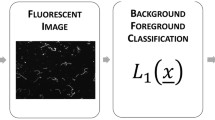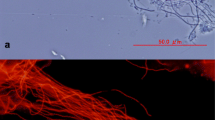Abstract
Toxic cyanobacterial blooms constitute a threat to human safety because Microcystis sp. releases microcystins during growth, and particularly during cell death. Therefore, analysis of toxic and nontoxic Microcystis in natural communities is required in order to assess and predict bloom dynamics and toxin production by these organisms. In this study, an analysis combining fluorescence in situ hybridization (FISH) with flow cytometry (FCM) was used to discriminate between toxic and nontoxic Microcystis and also to quantify the percentage of toxic Microcystis present in blooms. The results demonstrate that the combination of FISH and flow cytometry is a useful approach for studying the ecology of Microcystis toxin production and for providing an early warning for toxic Microcystis blooms.
Similar content being viewed by others
References
Ueno Y, Nagata S, Tsutsumi T, et al. Detection of microcystins, a blue-green algal hepatotoxin, in drinking water sample in Haimen and Fusui, endemic areas of Primary Liver Cancer in China, by highly sensitive immunoassay. Carcinogenesis, 1996, 17: 1317–1321, 1:CAS:528:DyaK28XjvFegurg%3D, 10.1093/carcin/17.6.1317, 8681449
Jochimsen E M, Carmichael W W, Jisi A. Liver failure and death after exposure to microcystins at a hemodialysis center in Brazil. New Engl J Med, 1998, 338: 873–878, 1:STN:280:DyaK1c7mslyisA%3D%3D, 10.1056/NEJM199803263381304, 9516222
Rapala J, Erkomaa K, Kukkonen J, et al. Detection of microcystins with 2protein phosphatase inhibition assay, high-performance liquid chromatography-UV detection and enzyme-linked immunosorbent assay comparison of methods. Anal Chim Acta, 2002, 466: 213–231, 1:CAS:528:DC%2BD38XmsVWisro%3D, 10.1016/S0003-2670(02)00588-3
Kurmayer R, Dittmann E, Fastner J, et al. Diversity of microcystin genes within a population of the toxic cyanobacterium Microcystis spp. in Lake Wannsee (Berlin, Germany). Microb Ecol, 2002, 43: 107–118, 1:CAS:528:DC%2BD38XjslGhtrs%3D, 10.1007/s00248-001-0039-3, 11984633
Meissner K, Dittmann E, Börner T. Toxic and non-toxic strains of the canobacterium Microcystis aeruginosa contain sequences homologous to peptide synthetase genes. FEMS Microbiol Lett, 1996, 135: 295–303, 1:CAS:528:DyaK28XovFKgsA%3D%3D, 8595871
Pan H, Song L, Liu Y, et al. Detection of hepatotoxic Microcystis strains by PCR with intact cells from both culture and environmental samples. Arch Microbiol, 2002, 178: 421–427, 1:CAS:528:DC%2BD38Xotl2rtrw%3D, 10.1007/s00203-002-0464-9, 12420161
Oberholster P J, Myburqh J G, Govender D, et al. Identification of toxigenic Microcystis strains after incidents of wild animal mortalities in Kruger National Park, South Africa. Ecotoxicol Environ Saf, 2009, 72: 1177–1182, 1:CAS:528:DC%2BD1MXkvVWjsb0%3D, 10.1016/j.ecoenv.2008.12.014, 19232725
Vaitomaa J, Rantala A, Halinen K, et al. Quanitative real-time PCR for determination of microcystin synthetase e copy numbers for Microcystis and Anabaena in lakes. Appl Environ Microbiol, 2003, 69: 7289–7297, 1:CAS:528:DC%2BD3sXpvFCls7Y%3D, 10.1128/AEM.69.12.7289-7297.2003, 14660378
Kurmayer R, Kutzenberger T. Application of real-time PCR for quantification of microcystin genotypes in a population of the toxic cyanobacterium Microcystis sp. Appl Environ Microbiol, 2003, 69: 6723–6730, 1:CAS:528:DC%2BD3sXptVyktL0%3D, 10.1128/AEM.69.11.6723-6730.2003, 14602633
Ha JH, Hidaka T, Tsuno H. Quantification of toxic Microcystis and evaluation of its dominance ratio in blooms using real-time PCR. Environ Sci Technol, 2009, 43: 812–818, 1:CAS:528:DC%2BD1MXnt1yi, 10.1021/es801265f, 19245020
Ingmar J, Kardinaal W E A, Marion M, et al. Toxic and nontoxic Microcystis colonies in natural populations can be differentiated on the basis of rRNA gene internal transcribed spacer diversity. Appl Environ Microbiol, 2004, 70: 3979–3987, 10.1128/AEM.70.7.3979-3987.2004
Franks A H, Harmsen H J M, Raangs G C, et al. Variations of bacterial populations in human feces measured by fluorescent in situ hybridization with group-specific 16S rRNA-targeted oligomucleotide probes. Appl Environ Microbiol, 1998, 64: 3336–3345, 1:CAS:528:DyaK1cXmtVajtrk%3D, 9726880
Manz W, Amann R, Ludwig W, et al. Application of a suite of 16S rRNA-specific oligonucleotide probes designed to investigate bacteria of the phylum cytophaga-flavobacter-bacteroides in the natural environment. Microbiology, 1996, 142: 1097–1106, 1:CAS:528:DyaK28XjtFyju7c%3D, 10.1099/13500872-142-5-1097, 8704951
Wilhelm S, Boris Z, Stella E, et al. In situ identification of cyanobacteria with Horseradish Peroxidase-labeled, rRNA-Targeted Oligonucleotide probes. Appl Environ Microbiol, 1999, 65: 1259–1267
Nyree J W, Wilhelm A S, Nicholas J F, et al. Closely related Prochlorococcus genotypes show remarkably different depth distributions in two oceanic regions as revealed by in situ hybridization using 16S rRNA-targeted oligonucleotides. Microbiology, 2001, 147: 1731–1744
Isabelle C B, Fabrice N, Daniel V, et al. Quantitative assessment of Picoeukaryotes in the natural environment by using taxon-specific oligonucleotide probes in association with tyramide signal amplification-fluorescence in situ hybridization and flow cytometry. Appl Environ Microbiol, 2003, 69: 5519–5529, 10.1128/AEM.69.9.5519-5529.2003
Sckar R, Fuchs B M, Amann R, et al. Flow sorting of marine bacterioplankton after fluorescence in situ hybridization. Appl Environ Microbiol, 2004, 70: 6210–6219, 10.1128/AEM.70.10.6210-6219.2004
Lei L M, Wu Y S, Gan N Q, et al. An ELISA-like time-resolved fluorescence immunoassay for microcystin detection. Clin Chim Acta, 2004, 348: 177–180, 1:CAS:528:DC%2BD2cXnsFSksbY%3D, 10.1016/j.cccn.2004.05.019, 15369752
Hu C L, Gan N Q, He Z K, et al. A novel chemiluminescent immunoassay for microcystin (MC) detection based on gold nanoparticles label and its application to MC analysis in aquatic environmental samples. Int J Environ Anal Chem, 2008, 88: 267–277, 1:CAS:528:DC%2BD1cXisFOlsrk%3D, 10.1080/03067310701657543
Rantala A, Fewer D P, Hisbergues M, et al. Phylogenetic evidence for the early evolution of microcystin synthesis. Proc Natl Acad Sci USA, 2004, 101: 568–573, 1:CAS:528:DC%2BD2cXmsFGntQ%3D%3D, 10.1073/pnas.0304489101, 14701903
Amann R I, Zarda B, David A S, et al. Identification of individual prokaryotic cells by using enzyme-labeled, rRNA-Targeted Oligonucleotide probes. Appl Environ Microbiol, 1992, 58: 3007–3011, 1:CAS:528:DyaK38XlvVGks74%3D, 1444414
Asai R, McNiven S, Ikebukuro K, et al. Development of a fluorometric sensor for the measurement of phycobilin pigment and application to freshwater phytoplankton. Field Anal Chem Technol, 2000, 4: 53–61, 1:CAS:528:DC%2BD3cXhs1Grurg%3D, 10.1002/(SICI)1520-6521(2000)4:1<53::AID-FACT6>3.0.CO;2-C
Lyck S. Simultaneous changes in cell quotas of microcystin, chlo rophyll a, protein and carbohydrate during different growth phases of a batch culture experiment with Microcystis aeruginosa. J Plankton Res, 2004, 26: 727–736, 1:CAS:528:DC%2BD2cXlt1Wls74%3D, 10.1093/plankt/fbh071
Kaya K, Watanabe M M. Microcystin composition of an axenic clonal strain of Microcystis viridis and Microcystis viridis-containing water-blooms in Japanese freshwaters. J Appl Phycol, 1990, 2: 173–178, 10.1007/BF00023379
Vasconcelos V M, Sivonen K, Evans W R, et al. Isolation and characterization of microcystins (heptapeptide hepatotoxins) from Portuguese strains of Microcystis aeruginosa Kutz. Emend Elekin Arch Hydrobiol, 1995, 134: 295–305, 1:CAS:528:DyaK2MXpvF2isrs%3D
Otsuka S, Suda S, Li R, et al. Phylogenetic relationships between toxic and nontoxic strains of the genus Microcystis based on 16S to 23S internal transcribed spacer sequences. FEMS Microbiol Lett, 1999, 172: 15–21, 1:CAS:528:DyaK1MXhtFaqurw%3D, 10.1111/j.1574-6968.1999.tb13443.x, 10079523
Neilan B A, Dittmann E, Rouhiainen L, et al. Nonribosomal peptide synthesis and toxigenicity of cyanobacteria. J Bacteriol, 1999, 181: 4089–4097, 1:CAS:528:DyaK1MXktFCisLY%3D, 10383979
Mikalsen B, Boison G, Skulberg O M, et al. Natural variation in the microcystin synthetase operon mcyABC and impact on microcystin production in Microcystis strains. J Bacteriol, 2003, 185: 2774–2785, 1:CAS:528:DC%2BD3sXjt1Gmsrs%3D, 10.1128/JB.185.9.2774-2785.2003, 12700256
Bates S S, Leger C, Keafer B A, et al. Discrimination between domoic-acid-producing and non-toxic forms of the diatom Pseudonitzschia pungens using immunofluorrescence. Mar Ecol Prog Ser, 1993, 100: 185–195, 1:CAS:528:DyaK2cXitFWru78%3D, 10.3354/meps100185
West N J, Bacchieri R, Hansen G, et al. Rapid quantification of the toxic alga Prymnesium parvum in natural samples by use of a specific monoclonal antibody and solid-phase cytometry. Appl Environ Microb, 2006, 72: 860–868, 1:CAS:528:DC%2BD28XmtFensQ%3D%3D, 10.1128/AEM.72.1.860-868.2006
Monfort P, Baleux B. Comparison of flow cytometry and epifluorescence microscopy for counting bacteria in aquatic ecosystems. Cytometry, 1992, 13: 188–192, 1:STN:280:DyaK387ptFOlsQ%3D%3D, 10.1002/cyto.990130213, 1547667
Author information
Authors and Affiliations
Corresponding author
Rights and permissions
About this article
Cite this article
Gan, N., Huang, Q., Zheng, L. et al. Quantitative assessment of toxic and nontoxic Microcystis colonies in natural environments using fluorescence in situ hybridization and flow cytometry. Sci. China Life Sci. 53, 973–980 (2010). https://doi.org/10.1007/s11427-010-4038-9
Received:
Accepted:
Published:
Issue Date:
DOI: https://doi.org/10.1007/s11427-010-4038-9




